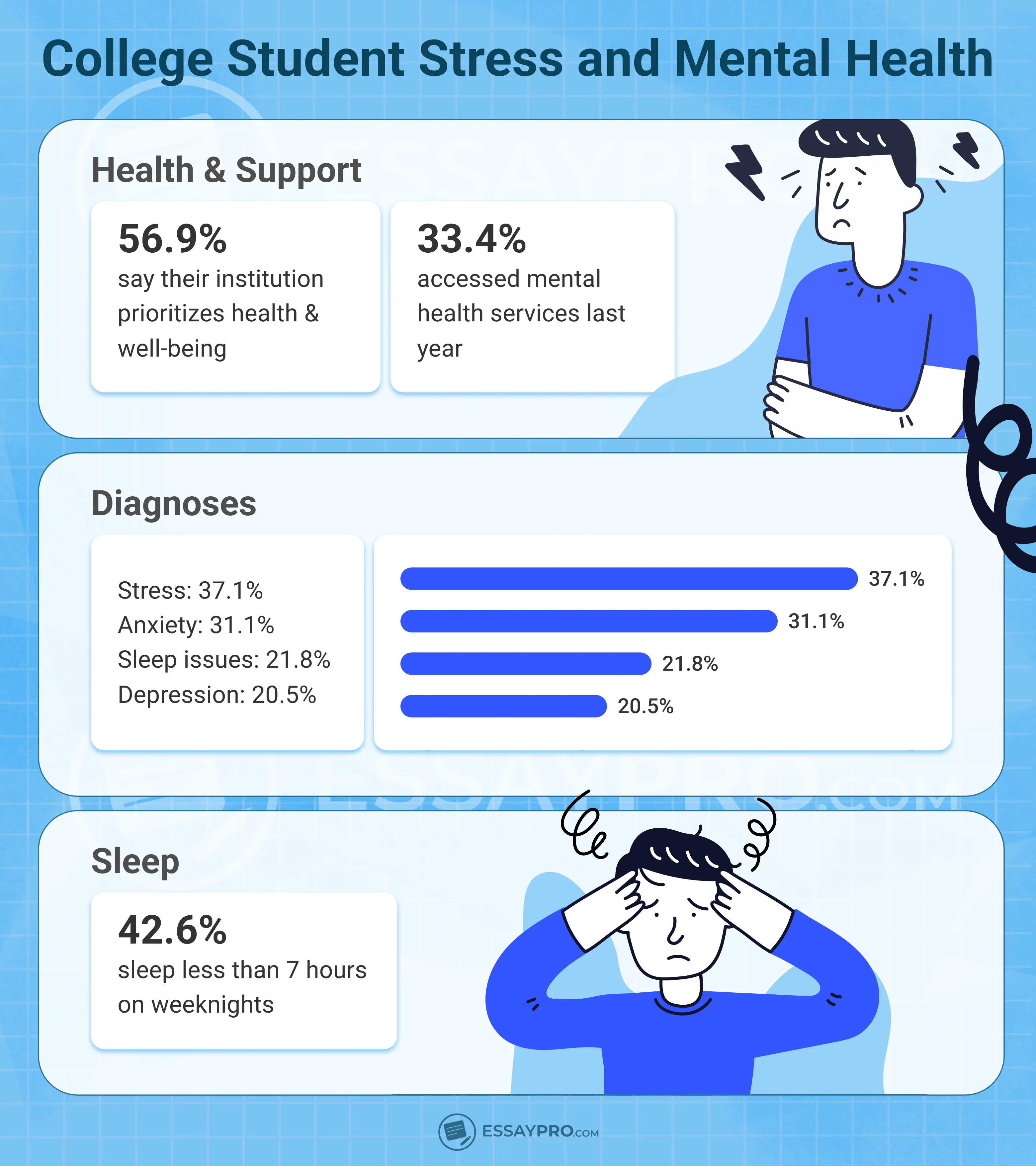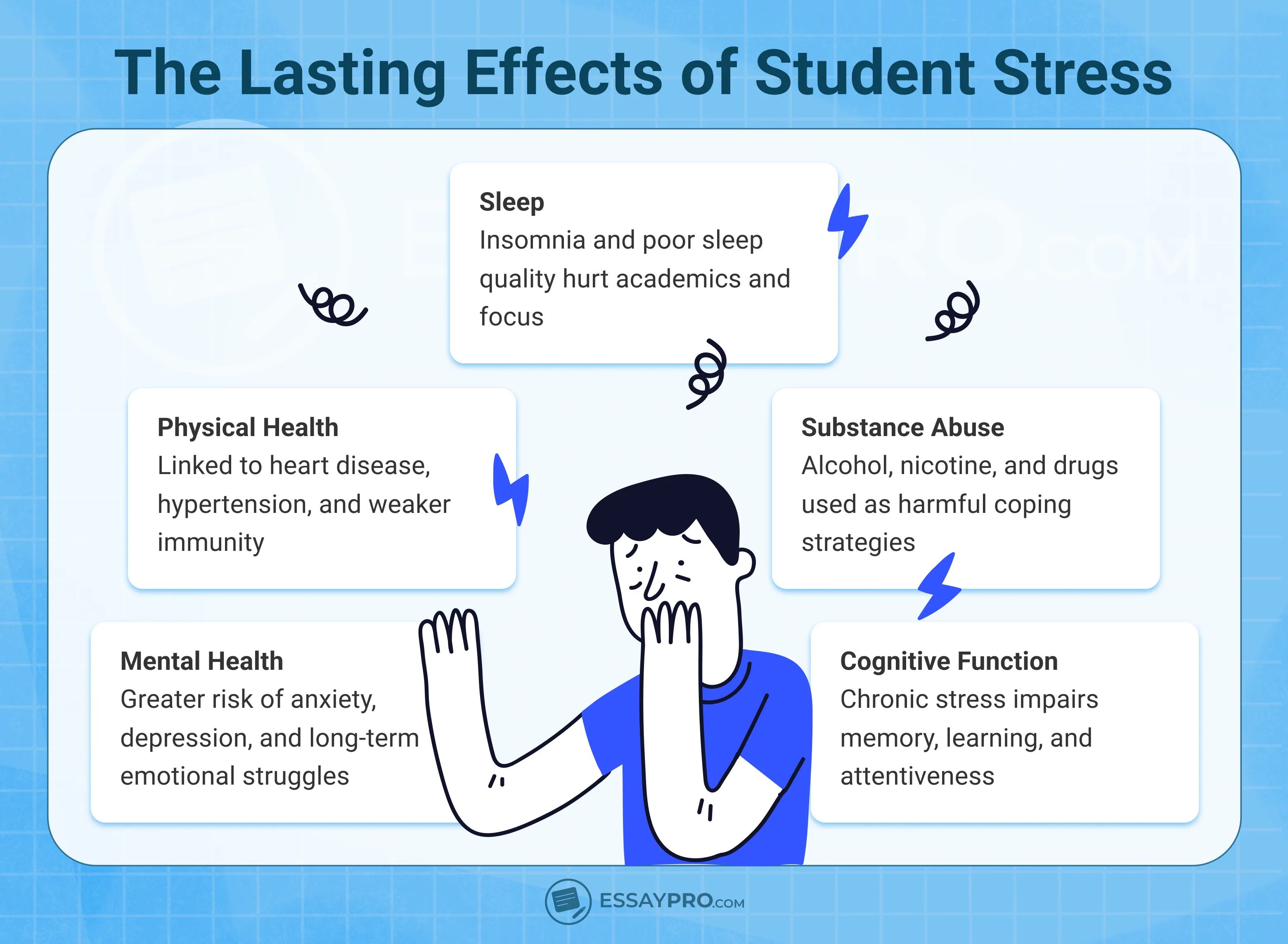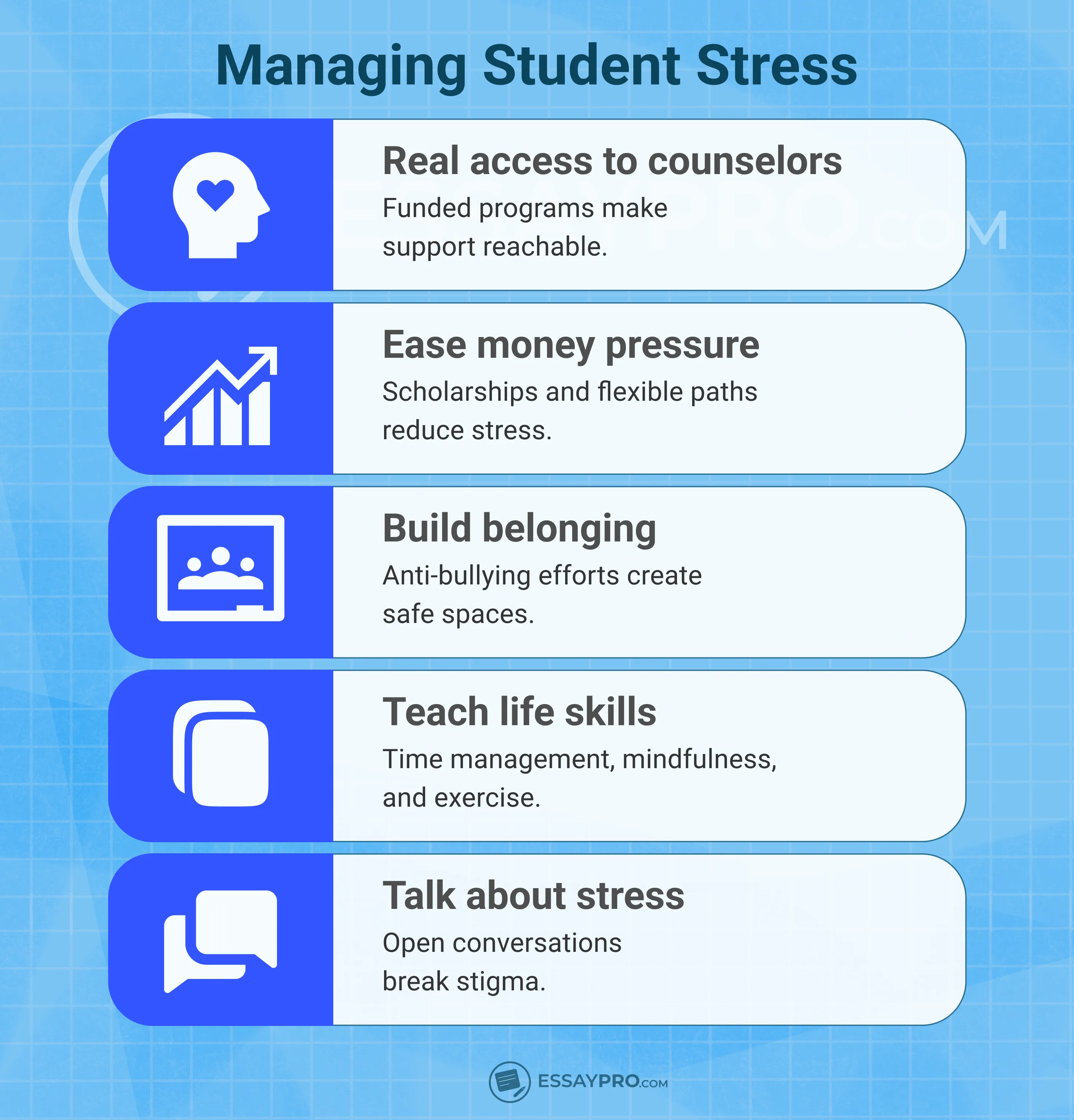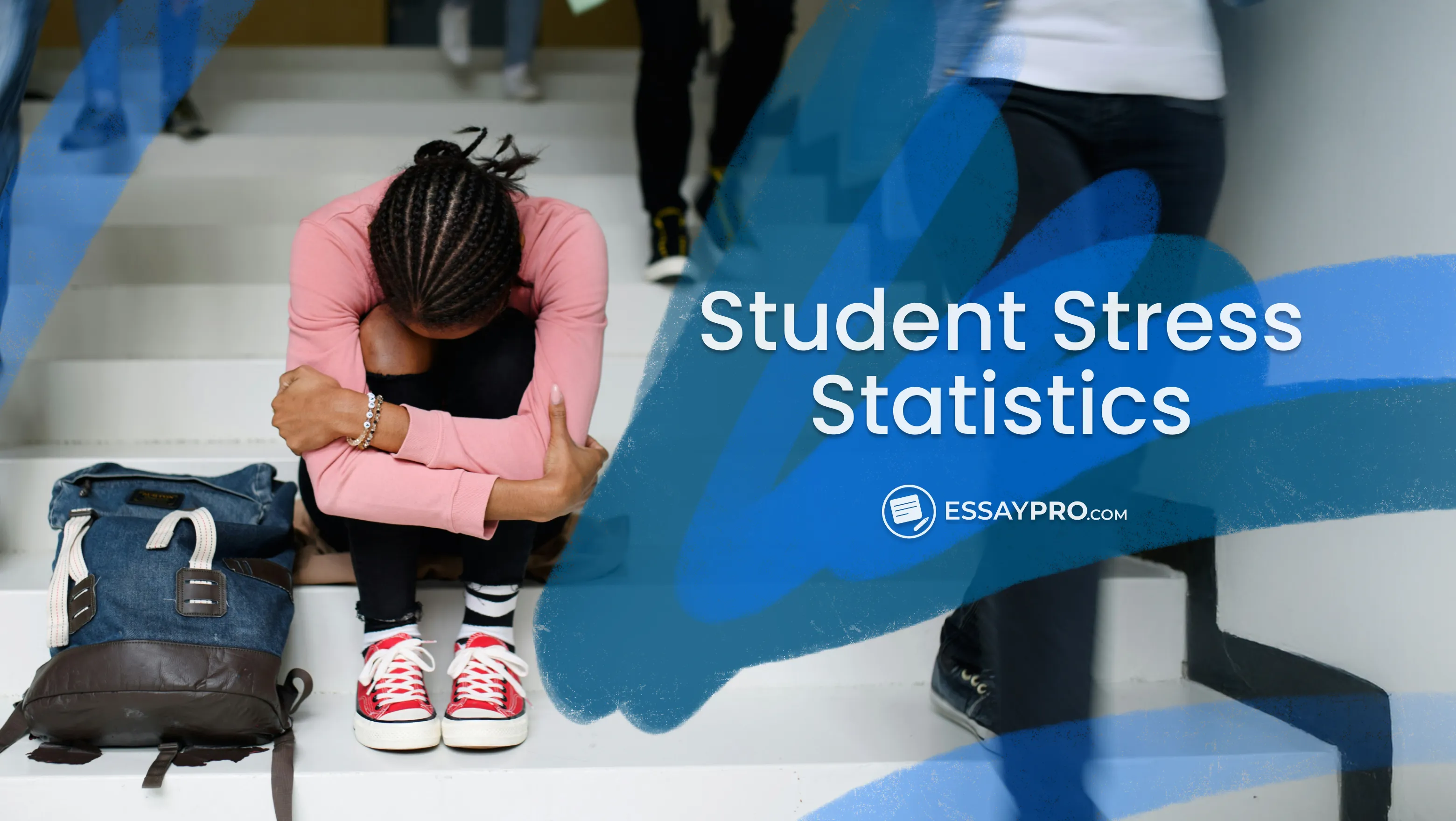Key Takeaways
- The prevalence of student stress is high: 60% of students feel stressed daily.
- Sleep deprivation hits 77% of high-schoolers.
- 68% of teens feel pressured to get top grades.
- 37% of college students are diagnosed with stress, 31% with anxiety, 21% with sleep problems, and 20% with depression.
- Nearly 1 in 5 teens report being attacked online.
- Only 7% of college students seek help.
- Better mental-health support and reduced academic pressure can change the picture.
Stress creeps in long before the first lecture or bell rings. The student stress statistics tell part of the story: 60% report feeling stressed every day, and 1 in 5 college students feel stressed all or most of the time. What makes it harder is that stress doesn’t stay in one lane. It leaks into sleep, mood, and memory, multiplying its reach.
At EssayPro, we give you the breathing room from academic stress you rarely get as a student, handling the demands of essays and research papers, so there’s space left for recovery.


Key Student Stress Statistics in 2025
Stress ripples across entire generations. Population-wide studies show that academic stress has become pervasive for students across age groups:
- Around 14% of children between 10 and 19 live with a diagnosed disorder, and for young adults, suicide has become the third leading cause of death.
- In a Pew Research Center report, nearly a third said anxiety and depression weren’t hidden struggles but everyday realities in their classrooms. Close to four in ten girls named it as a constant presence, compared with only a fraction of boys.
- More than 60% of teens in higher-income families (earning over US$75,000) expect to attend college. For those in low-income homes, 23% see the same path.
- Surveys show that nearly a quarter of young people feel extreme stress during the school year. In high schools, nearly half of the stressed students described themselves as persistently sad or hopeless.
How Stress Affects K-12 Learners
Middle‑ and high‑school students encounter a mix of academic, social, and physiological stressors. Statistics from public health and survey reports reveal:

- Sleep and fatigue: 34% of children aged 6-14, and 77% of adolescents and high‑school students, are sleep-deprived. Guidelines recommend 9 to 12 hours for the younger child, and 8 to 10 hours for the adolescent.
- Pressure to succeed: 68% of adolescents report that they feel pressure to receive good grades. Nearly 33% feel pressure to engage in extracurricular activities, and 41% of students report feeling pressure to fit socially within school.
- Appearance and gender expectations: 55% of teen girls feel pressured to look good, vs 39% of boys; 43% of boys feel pressure to be physically strong compared with 23% of girls. Girls also say it is easier to receive emotional support from friends (58%) than boys (7%).
- Aggression and safety: Boys are more likely to get into physical fights at school (44%) than girls (15%). Meanwhile, 30% of youth aged 14-25 said striving for high grades harmed their mental health, and 25% cited peer pressure.
An additional look at stress prevalence among younger students shows that academic demands are not the sole stressor: cross‑sector surveys reveal that 50% of middle‑school students and 75% of high‑school students feel academic stress all the time, and 61% of teens stress about producing satisfactory grades.
College and University Student Stress
Post-secondary learning and a university degree demand more extensive work, financial responsibility, and a new social environment.

- Health and well‑being: 56.9% of U.S. college students believed their institution emphasized their health and well‑being in 2024, and 33.4% accessed some form of psychological or mental‑health service within the past year.
- Diagnosis: A high percentage of college students will have been diagnosed or treated with stress (37.1%), anxiety (31.1%), sleep issues (21.8%), and depression (20.5%). Sleep remains an issue, with 42.6% sleeping less than seven hours on weeknights.
- Self‑harm and marginalised groups: 11.7% of students admitted to self‑harm in the last year. As for LGBTQ+ students, 66% experienced anxiety, and 53% experienced depression; half could not access the required mental health service.
- Athletics and graduate students: Stress doesn’t end with undergraduate students: 17% of male student athletes and 44% of female student athletes experienced feeling overwhelmed.
- Additional stressors: Data from other surveys show that 45% of college students feel stressed at a higher‑than‑average rate, and 20% say they have been stressed at least six times in the last 12 months. Relationship issues and financial concerns are also common stressors.
Energy and mindset can help you manage stress. Even music can reset the brain after a long day. We curated a playlist of motivational songs for students that can help you keep going when burnout sets in.
Major Causes of Student Stress
Causes of stress for students include heavy workload, constant pressure to achieve, bullying in school or online, homesickness, and excessive screen time.

Coursework
Academic stress due to higher studying demands is the most frequently cited stressor, with research showing how heavily workload shapes performance and well-being. Nearly 47.5% of U.S. college students report that procrastination negatively affects their academic performance. In college freshman surveys, 11% felt unprepared for the amount of study they had to do, and 6% found exams harder than they expected. Smaller but still significant groups, around four to five percent, of first-year students were affected by other elements, such as workload, class sizes, etc.
Among adolescents, 71% of girls and 65% boys indicate feeling pressure to do well at school, revealing the widespread weight of achievement. In addition to this, over a quarter (27%) of boys and girls reported feeling burnt out.
For students who feel buried under numbers and formulas, getting statistics homework done can be a practical way to relieve pressure.
Bullying and Social Media
Bullying remains a powerful source of stress for students, especially when it extends into digital spaces. The World Health Organization’s European arm reported that around 11% of teens are bullied at school and 15% are cyberbullied. In the United States, the picture is equally troubling: 14.5% of students aged 12-18 experience repeated bullying. The issue is especially pronounced during the middle-school years, where 26.3% of students are affected, compared with 15.7% in high school, and 21.6% of students in grades 6-12 have been attacked online or via text.
Heavy social‑media use also correlates with stress: U.S. teens spend 4.8 hours per day on popular apps, while 60% of intense social‑media users report low parental monitoring and weak parental relationships. Even children as young as eight spend long stretches online, with 65% of Gen Alpha kids using social platforms for four hours daily.
Family Distance
Living away from home often creates homesickness and added stress, especially for students navigating independence for the first time. Survey data from two- and four-year U.S. colleges show that 45.44% of students sometimes felt homesick, 43.66% did not, and 10.96% often felt homesick. Freshman surveys give more detail: when asked whether they missed home often, 14% said 'yes', 21% said 'sometimes', and 37% said 'rarely'.
Beyond missing family, students also reported worries about managing life on their own. According to the data, 9.7% of students were 'very worried' about living away from home, 17.3% were 'somewhat worried', and 27.2% 'only slightly worried'. This demonstrates the impact of being away from family and related factors, causing additional stress. For many students, the stress of adapting to an entirely new environment magnifies academic pressure and contributes to broader feelings of instability during college life.
The Student Mental Health Crisis
Student stress is not just a short-term problem tied to exams or heavy workloads. It often develops into deeper mental-health challenges that affect daily functioning and long-term well-being. Data from universities show that, in addition to widespread stress and anxiety, students are being diagnosed with several other conditions at concerning rates. Students were recently treated or diagnosed with ADHD/ADD (12.9%), eating disorders (3.6%), and PTSD (3%). Risky behaviors intensify this issue. These conditions frequently overlap, creating an even heavier burden for young people trying to succeed academically while managing their health.
Stress also drives risky behaviors that can worsen the cycle. Many students report moderate risks of substance use as temporary coping mechanisms. These habits may provide short relief but ultimately make mental health more fragile. The combination of untreated conditions, stress, and harmful behaviors paints a troubling picture of a student population under enormous pressure.
Student Stress Around the World
Limited cross‑national data suggest that stress levels differ by country, but the numbers show a common thread: students are struggling all over the world. These figures below highlight how widespread the challenge has become.
In the United States, about 67% of students report high levels of stress, while in the United Kingdom, a lower but still significant 55%. Australia falls in the middle with 64%, reflecting pressures tied to both coursework and social expectations. Canada records one of the highest rates at 72%, pointing to the intensity of academic competition and the rising costs of education. Japan stands out with the highest rate, as 80% of students say they struggle with stress on a daily basis.
Countries with high rates of chronic stress, such as Japan and Canada, suggest national systems that push students towards getting more than they can handle. Countries with lower, but still concerning rates (like the U.K. and U.S.) suggest that academic and social pressures are universal. The pattern is clear: stress is not an issue; it is a constant in student life.
Lasting Effects of Student Stress
Chronic stress related to education can have permanent and grave consequences. Research has shown that consistent exposure to stress can lead to:

- Mental health issues: Chronic stress increases the likelihood of anxiety disorders, depression, and other mental health issues that may persist into adulthood and that compromise quality of life, work performance, and interpersonal relationships.
- Physical health issues: Chronic stress leads to distress in the cardiovascular system, which can produce hypertension and heart disease, as well as bring vulnerabilities in our immune systems that make the body more likely to become sick and increase the possibility of school and/or work absenteeism.
- Sleep issues: Stress leads to sleep issues because it alters sleep patterns and quality (symptoms of insomnia), which causes impairments in mental health and academic performance.
- Substance abuse: A variety of stressed students with chronic stress will consume alcohol, nicotine or drugs as coping strategies. These coping strategies are addictive and harmful.
- Cognitive functioning: Ongoing stress can distort memory, learning, and attentiveness, creating academic challenges that will extend into future jobs/careers with diminished cognitive performance.
Why So Few Students Reach Out for Help?
Only 7% of college students utilize the services of a mental-health professional for stress or depression.
Most U.S. public schools now offer some kind of mental-health support, but having services available doesn’t always mean students use them. The problem mainly lies in staff shortages and tight budgets.
Even with access to help, many young people don't seek help. Among youth with major depressive episodes, less than half will ever receive outpatient therapy, and only about a third will utilize telehealth. Stigma still prevents students from talking, and the runaround in accessing school-based resources can be so overwhelming that it prevents students from even trying. Money and wait times add another layer. College surveys show that 42% of students stopped getting care once a semester ended, and getting an appointment often takes a full week.
Managing Student Stress
Stress won’t disappear with a single fix. It takes effort from schools, communities, families, and students themselves. The good news is that there are physiology-based, actionable steps that can alleviate that stress.

- Mental-health access: Students need access, not just good intentions. Access means enough counselors in schools and enough funding to supply the programs, so that help is accessible.
- Less financial pressure: When tuition and living costs weigh heavily, learning becomes secondary. Scholarships and internships for international students in USA, affordable programs, and flexible learning paths can alleviate that burden.
- Safer classrooms: A school that actively prevents bullying and creates a sense of belonging in its community gives students collaborative space. Peer and mentor groups are often the lifeline that makes a difficult week feel manageable.
- Practical coping skills: Teaching time management, mindfulness, and self-care is survival training. And with regular sleep and exercise, students are far better equipped to handle the inevitable pressures of academics.
- Making help normal: Talking about stress and mental health out loud breaks the silence. Schools can lead by being transparent about available resources.
Wrapping It Up
These statistics paint a clear picture of how students, from middle school to graduate programs, struggle with academic demands, social pressures, financial concerns, and mental health problems. But still, there is hope, and it lies in recognizing these challenges and acting to prevent and mitigate them.
To ease the burden of academic responsibilities, you can turn to EssayPro. Using our assistance with complex tasks, including finance assignment help, you can free up time for mental health care!
FAQs
What Percent of Students Are Stressed by School?
Surveys indicate that 45 % of high‑school students admit to being stressed almost every day, and 50 % of middle‑school students feel academic stress all the time. In the broader student population, 60 % report feeling stressed daily.
How Prevalent Is Stress Among College Students?
Data show that 37.1 % of college students were diagnosed or treated for stress, 31.1 % for anxiety, 21.8 % for sleeping difficulties, and 20.5 % for depression.
What Mental-Health Support Is Available for Students?
Most U.S. public schools provide some mental‑health services, 84 % offer individual interventions, 70 % provide case management, and 67 % expanded these services during the pandemic. Colleges often have counseling centers, peer‑support groups, and crisis hotlines.

Mariam Navrozashvili
She has a Master’s degree in English Literature and brings a deep understanding of storytelling, critical analysis, and language structure to her work. On EssayPro Blog Mariam writes guides on literary analysis, essay composition and language studies to help students improve their writing skills. In her free time she likes to read classic novels and discuss literary theory.
- American Institute of Stress. (n.d.). Stress in teens and young adults. Retrieved April 1, 2025, from https://www.stress.org/who-gets-stressed/teens-young-adults/
- Centers for Disease Control and Prevention. (2024). Fast stats: Sleep in high school students. https://www.cdc.gov/sleep/data-research/facts-stats/high-school-students-sleep-facts-and-stats.html
- K-12 Dive. (2023). Where do we go from here? How K-12 schools can support the mental health of students and educators. Pearson Assessments. https://www.pearsonassessments.com/content/dam/school/global/clinical/us/assets/k-12/pearson-k12-dive-industry-outlook-report.pdf
- Mowreader, A. (2024, February 2). Data: Homesickness affects over half of all students. Inside Higher Education. https://www.insidehighered.com/news/student-success/health-wellness/2024/02/02/soothing-homesick-college-students-support
- Parker, K., & Hurst, K. (2025, March 13). The gender gap in teen experiences. Pew Research Center. https://www.pewresearch.org/social-trends/2025/03/13/problems-teens-see-in-their-schools/
- StopBullying.org. (n.d.). Facts about bullying. Retrieved April 2, 2025, from https://www.stopbullying.gov/resources/facts
- The Trevor Project. (2024). 2024 U.S. national survey on the mental health of LGBTQ+ young people. https://www.thetrevorproject.org/survey-2024/
- Weinstein, E., Konrath, S., Lara, E., Tench, B., James, C., Mann, S., & Lenhart, A. (2024). Unpacking grind culture in American teens: Pressure, burnout, and the role of social media. Common Sense Media, Center for Digital Thriving, and Indiana University. https://www.commonsensemedia.org/research/unpacking-grind-culture-in-american-teens-pressure-burnout-and-the-role-of-social-media
- Ambitions ABA. (n.d.). Ambitions ABA. Retrieved April 2, 2025, from https://www.ambitionsaba.com/








